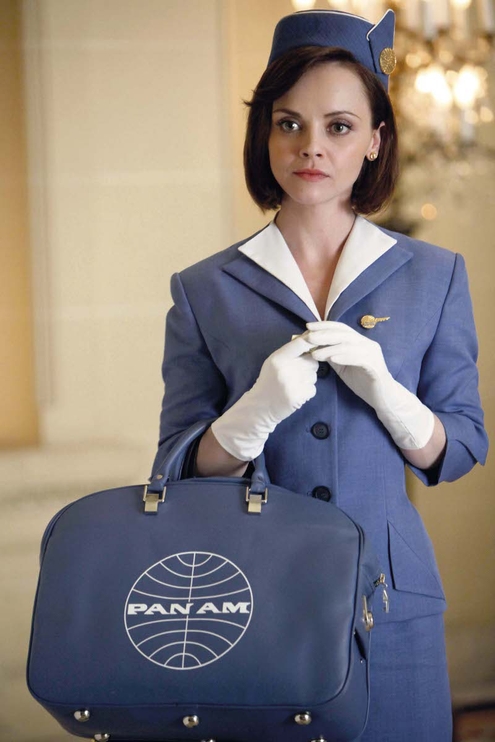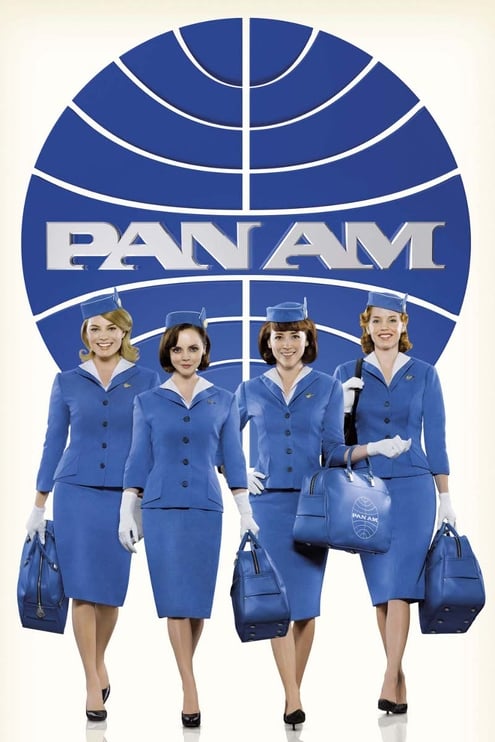Pan Am is set to be the biggest new television show of the year. Hot on the heels of period dramas like Downton Abbey and Mad Men, the costumes will take centre stage and will inspire collections for seasons to come. Costume designer, Ane Crabtree, talks about her work on set.
“It’s outrageous how sexy that constraint could be,” Pan Am costume designer Ane Crabtree says of the demure uniforms the stewardesses wore back in 1963. “A lot of Prada’s early designs are based on uniforms. The uniform is so splendid in its simplicity and what it’s supposed to do.”
Crabtree came into her own designing costumes for the pilot of HBO’s seminal series The Sopranos. Although she didn’t work with Pan Am production designer, Bob Shaw (who worked on the series), she says, “I feel like we are symbiotic twins. If there’s anybody I would want to create with alongside, it’s him. I was told my whole career I should work with him. We kind of design by osmosis, because of the lack of time that is typical of television. We have a similar stance visually.”

Christina Ricci takes the lead as Maggie in the high-flying series
Crabtree has been busy ever since, recently creating Timothy Olyphant’s iconic look in FX’s Justified and working on HBO’s upcoming Luck, starring Dustin Hoffman and Nick Nolte and executive-produced by Michael Mann and David Milch. But Pan Am, executive produced by creator Jack Orman, Thomas Schlamme and Nancy Hult Ganis (who was a real life Pan Am stewardess in the ‘60s and ‘70s) represents one of Crabtree’s biggest challenge to date.
Beyond the attention to period-detail, she says, “Here, our work is compounded by the fact that we depict costumes from one to four countries per episode. I feel like, ’Who gets to do this in the land of TV?’ It feels very film-world.”
Crabtree notes the desire to plop a viewer in the thick of the action means authenticity is of the utmost importance. She says the specific attention to each individual ensemble separates Pan Am from most shows currently on television.
“It’s difficult,” she adds, “because the writers are always thinking big. The thing that keeps us different is we do so much research on Rangoon, Burma, Jakarta or Indonesia – we’re not just creating something that looks like ‘anywhere Asia.’ With tiny little visual clues or patches we can say, ‘This is 1963 Paris.’ There are beautiful secrets in clothing and costumes that inform the place. Sometimes the costumes are a literal documentary; other times, they’re more painterly and emotional.”
These nuances are especially important when the leads are out of their Pan Am garb. Crabtree strives to ensure the individual’s clothing underscores their personalities, which in turn helps performers in establishing their characters’ period sensibilities. “Fashion is important to me – it creates a visual impact,” she says. “The actor hasn’t been taken away and catapulted into 1963. Rather, it’s something they haven’t experienced before and the combination of vintage and fashion helps take them away to that place, that moment in time.”
Referring to a dress boasting a bold green and flower pattern created for Christina Ricci’s Maggie, an invaluable member of the flight team despite her blithely disobeying the airline’s rule on wearing girdles, Crabtree explains, “Maggie’s a hellcat, the rare bird of the bunch who’s not afraid to stand out. Maggie bends the rules a bit. She’s bohemian, ladylike but brash, American and a free spirit.”

The Pan Am ladies, Maggie, Laura, Kate and Collette, ready to take flight
For Laura (Margot Robbie), who impulsively abandons her own wedding to join Pan Am’s crew of international stewardesses, Crabtree designed a dress with white, mauve and green stripes cinched at the waist.
“She’s very much the lady, wanting to do right by her family, whereas Kate (her sister, played by Kelli Garner) is the opposite,” Crabtree explains. “Laura’s caught between two worlds, so she’s in a dress that would make her mother happy. It’s a casual shirt waist that’s enchantingly female in its simplicity. Men want to grab women by their waist. It’s a simple, girl-next-door look, but there’s a sensuality to it. It’s a perfect picture of suburban, keeping-up-with-the-Jones mentality, statuesque and beautiful. The green, psychologically, suggests she’s starting her life over.”
As for Laura’s sister, Crabtree says, “Kate is compelling – Kate reminds me of my aunt, who was a TWA stewardess, so I throw a little bit of her into Kate. She’s a serious girl and a voluptuous woman. She’s the intellectual one — a lady with a body for sin but a mind for business. She’s so 1960s spot-on. You don’t have to do a thing to make us believe she belongs in that time.”
Kate also happens to be moonlighting for a U.S. intelligence agency, performing small acts of espionage on her overseas layovers. Crabtree says she created a slightly out-of-character cocktail dress for Kate for a romantic subplot.
Crabtree explains. “I created a white gown via Marilyn (Monroe), what she wore when she sang happy birthday to JFK, and I also looked for a neutral colored chemise with feather trim- very Ann Margaret, to make her pop and stand out in a sea of men donning black and white tuxedos. It’s a way to play with her character. Not often will she be looking like that. Wherever she goes, there’s a covert feeling in her clothing, but the exception is this dress.”
Lastly, Crabtree describes a vaguely avant-garde creation for Collette (Karine Vanasse), a French stewardess.
“Collette is quintessentially French, very fashion forward, which makes her different – what she wears is not anything you’ve seen in America,” she says. “Nothing conservative for her. Her dress is supremely tailored to her body; there’s nothing you can see or that is exposed. You’re allured by the skin you know that’s underneath. She is very free-spirited, very classic and timeless. She’s a subtle, quiet beauty. Nothing is brusque. It’s hushed, with just a blush of a color.”
Crabtree believes the core of the characters emerges visually in their off-duty attire, while the minimalist beauty of the uniforms represents the equalizing reality of Pan Am.
Of the actors and their costumes, Crabtree reiterates, “The truth of the character comes out in the clothing beyond the uniform because you’re not trying to hide yourself. You’re taken to exotic places, in beautiful individual looks, then you return to a place of simplicity and truth with the Pan Am uniform. The uniform is resplendent in its clean lines and utilitarian design. In a sense, you’re striving away from reality and then turning around and returning to where you were, all in one episode.”

